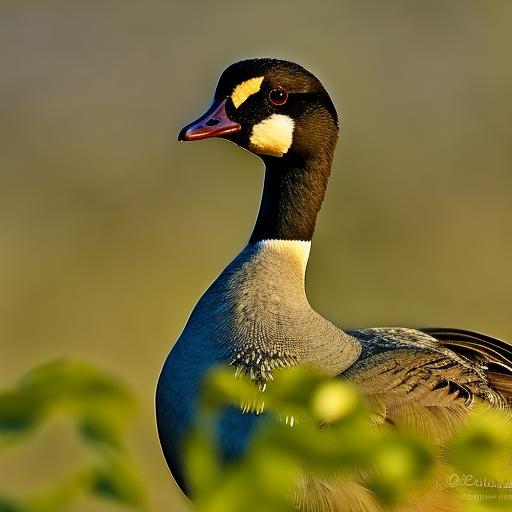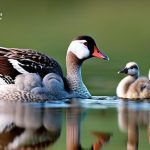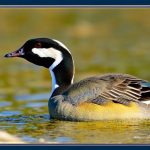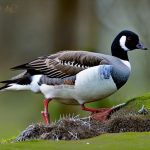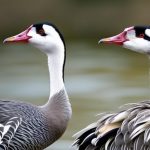Every year, as winter turns to spring, the skies of Illinois are filled with the honking of Canada geese as they make their annual migration back to their breeding grounds. These majestic birds, known for their distinctive V-shaped flight formations, travel thousands of miles from their wintering grounds in the southern United States and Mexico to reach their breeding grounds in Illinois. The arrival of Canada geese in Illinois is a sure sign that spring has arrived, and it marks the beginning of the breeding season for these iconic birds.
As the temperatures begin to warm and the snow and ice melt away, Canada geese start to arrive in Illinois in late February and early March. They are drawn to the state’s abundant wetlands, lakes, and rivers, where they will build their nests and raise their young. The arrival of Canada geese in Illinois is a sight to behold, as flocks of these birds can be seen flying overhead or gathering in large numbers on the water. Their arrival signals the start of a busy and important time for these birds as they prepare to breed and raise their young in the Prairie State.
Nesting habits and preferences of Canada geese
Once Canada geese have arrived in Illinois, they begin to search for suitable nesting sites where they can lay their eggs and raise their young. These birds have a strong preference for nesting near water, as it provides them with easy access to food and protection from predators. They often choose to build their nests on small islands, marshy areas, or the shores of lakes and rivers, where they can keep a close eye on their surroundings and defend their territory.
Canada geese are known for their large, bulky nests, which they build using a combination of grasses, reeds, and other plant materials. The female goose will lay a clutch of 4-6 eggs, which she will incubate for around 25-28 days. During this time, the male goose will stand guard and protect the nest from potential threats. Once the eggs hatch, both parents will take on the responsibility of caring for and raising their goslings. They will lead their young to water, where they will teach them how to swim, forage for food, and avoid danger. The nesting habits and preferences of Canada geese are essential to their breeding success, and they play a crucial role in ensuring the survival of their species in Illinois.
The role of both parents in incubating and raising goslings
The breeding season is a busy time for Canada geese, and both parents play a crucial role in incubating and raising their goslings. After the female goose has laid her eggs, she will spend the majority of her time incubating them, keeping them warm and protected until they are ready to hatch. During this time, the male goose will stand guard and defend the nest from potential threats, such as predators or other geese looking to take over their territory.
Once the eggs have hatched, both parents will take on the responsibility of caring for their goslings. They will lead their young to water, where they will teach them how to swim and forage for food. Canada geese are known for their strong family bonds, and both parents will work together to ensure the safety and well-being of their goslings. They will fiercely defend their young from predators and other threats, and they will teach them important survival skills that will help them thrive in the wild. The role of both parents in incubating and raising goslings is essential to the survival of Canada geese in Illinois, and it highlights the strong bond and dedication these birds have to their offspring.
Challenges faced by Canada geese during breeding season
While the breeding season is a time of great excitement and activity for Canada geese, it also presents a number of challenges for these birds. One of the biggest challenges they face is finding suitable nesting sites that are free from disturbance and predators. As human development continues to encroach on their natural habitats, Canada geese are often forced to nest in urban and suburban areas, where they are more vulnerable to disturbances and threats from people and pets.
Another challenge that Canada geese face during the breeding season is the risk of predation. Their nests and young are vulnerable to predators such as foxes, raccoons, and birds of prey, which can pose a significant threat to their survival. In addition, severe weather events, such as heavy rain or hail, can also have a negative impact on their breeding success. These challenges highlight the importance of protecting and preserving the natural habitats of Canada geese in Illinois, and the need for conservation efforts to ensure their survival during the breeding season.
Impact of human activities on Canada geese breeding in Illinois
Human activities have a significant impact on the breeding success of Canada geese in Illinois. As the state’s population continues to grow, the demand for land and resources has led to the destruction and fragmentation of their natural habitats. Wetlands, lakes, and rivers that were once prime nesting sites for Canada geese have been drained, filled in, or developed for agriculture and urbanization, leaving these birds with fewer options for suitable nesting sites.
In addition, human disturbances, such as boating, fishing, and recreational activities, can disrupt the breeding behavior of Canada geese and cause them to abandon their nests. The presence of people and pets near nesting sites can also increase the risk of predation and stress for these birds, which can have a negative impact on their breeding success. Furthermore, pollution and contamination of waterways can affect the quality of the food and water available to Canada geese, which can impact their health and reproductive success. The impact of human activities on Canada geese breeding in Illinois underscores the need for conservation efforts to protect and preserve their natural habitats and ensure their survival during the breeding season.
Canada geese behavior during the breeding season
During the breeding season, Canada geese exhibit a number of unique behaviors as they prepare to nest and raise their young. One of the most noticeable behaviors is their vocalization, as they can often be heard honking loudly as they communicate with each other and defend their territory. This vocalization is a way for Canada geese to establish and maintain their pair bonds, as well as to warn off potential threats and intruders.
Another behavior exhibited by Canada geese during the breeding season is their aggressive defense of their nesting sites. They will fiercely defend their territory from other geese and predators, using their wings and beaks to intimidate and drive away any potential threats. This behavior is essential for protecting their nests and ensuring the safety of their young. In addition, Canada geese will also engage in courtship displays, such as head bobbing, neck stretching, and wing flapping, as a way to strengthen their pair bonds and establish their breeding territories. These behaviors are all part of the complex and fascinating breeding behavior of Canada geese, and they play a crucial role in ensuring the success of their breeding season in Illinois.
The migration patterns of Canada geese in Illinois
After the breeding season comes to an end, Canada geese in Illinois begin to prepare for their annual migration back to their wintering grounds. As the days grow shorter and the temperatures start to drop, these birds will gather in large flocks and begin their journey southward. The migration patterns of Canada geese in Illinois are a remarkable sight to behold, as thousands of these birds can be seen flying overhead in their distinctive V-shaped formations.
The migration of Canada geese is a long and arduous journey, as they travel thousands of miles to reach their wintering grounds in the southern United States and Mexico. They will stop at various staging areas along the way to rest and refuel, taking advantage of the abundant food and water available in these areas. Once they reach their wintering grounds, Canada geese will spend the winter months feeding and resting, before they begin the journey back to their breeding grounds in Illinois in the spring. The migration patterns of Canada geese in Illinois are a testament to the incredible endurance and resilience of these birds, and they highlight the importance of protecting and preserving their habitats along their migration routes.
Canada geese population trends in Illinois
The population of Canada geese in Illinois has fluctuated over the years, as a result of various factors such as habitat loss, hunting pressure, and changes in climate. In the early 20th century, Canada geese were on the brink of extinction in Illinois, due to overhunting and loss of their natural habitats. However, through conservation efforts and the establishment of protected areas, the population of Canada geese has rebounded significantly in recent decades.
Today, Canada geese are a common sight in Illinois, and their population continues to thrive in the state’s wetlands, lakes, and rivers. The establishment of wildlife refuges and protected areas has provided these birds with safe and suitable habitats for breeding and raising their young. In addition, regulations on hunting and the implementation of conservation programs have helped to ensure the long-term survival of Canada geese in Illinois. The population trends of Canada geese in Illinois are a testament to the success of conservation efforts and the importance of protecting and preserving their natural habitats.
The importance of Canada geese in Illinois ecosystems
Canada geese play a vital role in Illinois ecosystems, as they help to maintain the balance and health of wetlands, lakes, and rivers. As herbivores, Canada geese feed on a variety of aquatic plants, grasses, and sedges, which helps to control the growth of vegetation and prevent the overgrowth of certain plant species. In addition, their droppings provide important nutrients to the soil and water, which can benefit the growth of other plants and organisms in the ecosystem.
Furthermore, Canada geese are an important food source for a variety of predators, such as foxes, coyotes, and birds of prey, which helps to support the diversity and abundance of wildlife in Illinois. Their presence also provides recreational and educational opportunities for people, as they are a popular species for birdwatching and wildlife photography. The importance of Canada geese in Illinois ecosystems cannot be overstated, as they contribute to the overall health and biodiversity of the state’s natural habitats.
Conservation efforts to protect Canada geese during breeding season
Conservation efforts to protect Canada geese during the breeding season are essential for ensuring the long-term survival of these birds in Illinois. One of the most important conservation measures is the preservation and restoration of their natural habitats, such as wetlands, lakes, and rivers, which provide them with suitable nesting sites and food sources. This can be achieved through the establishment of wildlife refuges, protected areas, and conservation easements, which can help to safeguard these critical habitats from development and disturbance.
In addition, regulations on hunting and the implementation of hunting seasons can help to manage the population of Canada geese and prevent overharvesting. This can help to ensure that these birds have the opportunity to breed and raise their young without the threat of excessive hunting pressure. Furthermore, public education and outreach programs can help to raise awareness about the importance of protecting and preserving the natural habitats of Canada geese, and encourage people to take steps to minimize disturbances and threats to these birds during the breeding season. Conservation efforts to protect Canada geese during the breeding season are crucial for ensuring the continued survival and well-being of these iconic birds in Illinois.
Meet Walter, the feathered-friend fanatic of Florida! Nestled in the sunshine state, Walter struts through life with his feathered companions, clucking his way to happiness. With a coop that’s fancier than a five-star hotel, he’s the Don Juan of the chicken world. When he’s not teaching his hens to do the cha-cha, you’ll find him in a heated debate with his prized rooster, Sir Clucks-a-Lot. Walter’s poultry passion is no yolk; he’s the sunny-side-up guy you never knew you needed in your flock of friends!

